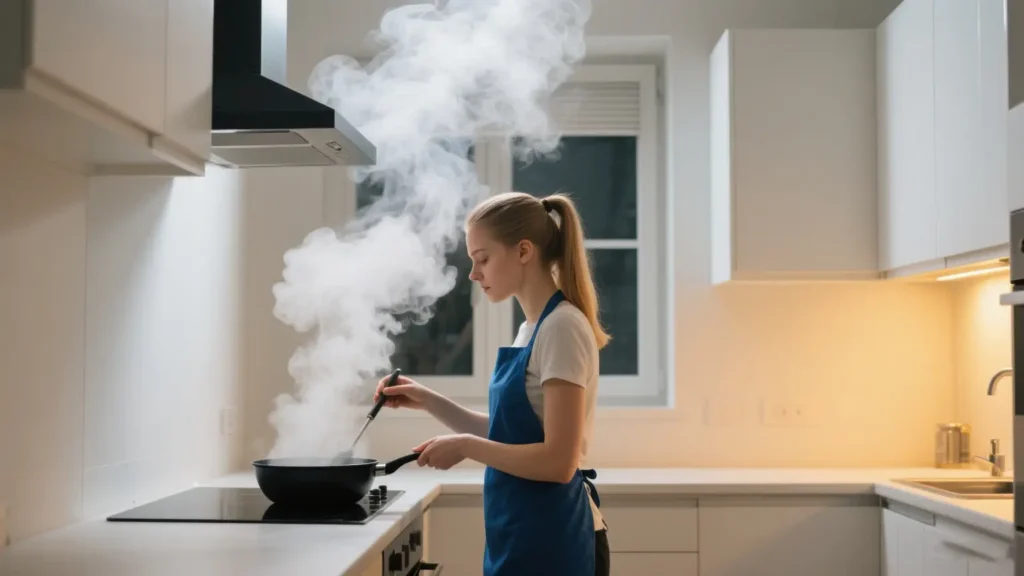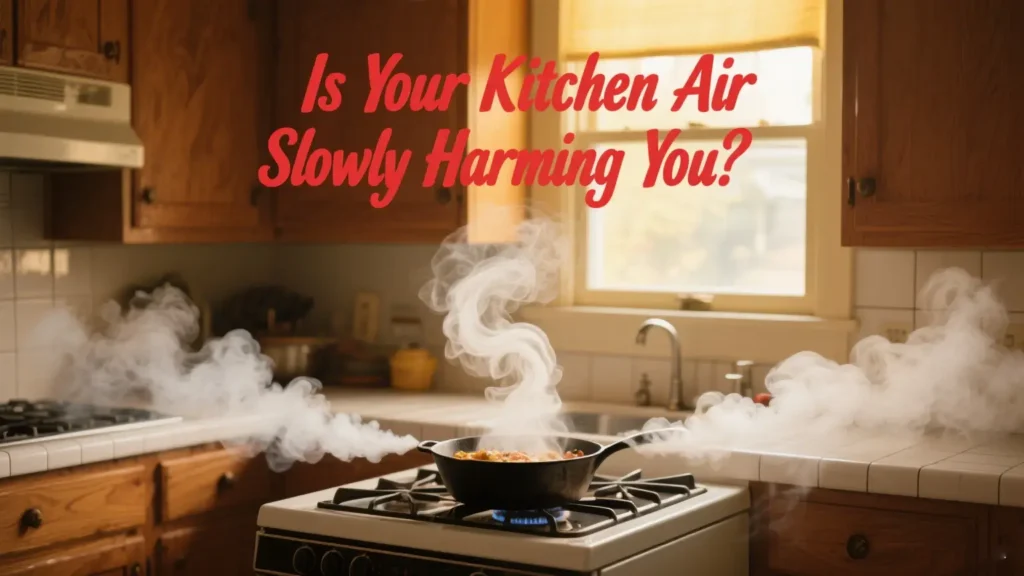We usually associate air pollution with the view of standing in the traffic on roads or the smoky environment of industrial areas. Almost never do we imagine that the fumes from our kitchens could be dangerous. Nevertheless, the process of cooking, especially if it is carried out daily and in an unventilated environment, can pose a grave danger to the health of the persons in the household. This is because it results in the generation of noxious fumes.
Even with the electrical kitchen devices getting better and better, still, it is a matter of fact that most of our kitchens are unequipped to effectively manage the dangerous fumes. If you are not changing the filters and/or are using the kitchen regularly with gas stoves, deep frying, or cooking at high temperatures without an exhaust fan on, you may be subjecting yourself to a variety of hazards by your own actions.
Let us probe into the reasons for kitchen fumes being toxic, the nature of their effects and what you can do in order to ensure that your house and health are safe.

Understanding What Kitchen Fumes Really Are
The fumes produced during cooking are not only an annoying thing, or a source of little trouble. They are a mixture of substances which are highly detrimental to your health. They may include particulate matter (PM2.5), volatile organic compounds (VOCs), carbon monoxide (CO), and nitrogen dioxide (NO₂). It is these dangerous pollutants that are released into the indoor air when people carry out their cooking activities like frying, grilling and baking mainly using oil or gas appliances.
Never get fooled by the amazing sound and delectable smell that come with open flames and the sizzling of food—fumes are killing. The smell and the smoke are far from any other explanation other than a fire in the pan. The combination of these factors causes the generation of particles and gases that are left in the atmosphere for a long time, thus causing pollution. These fine particles are so small that they can pass into our bodies, taking harmful elements into our lungs, and/or further into the bloodstream.
The wide spread of gas stoves is a major source of indoor air pollution. Research demonstrates that kitchens without proper gas extraction could have levels of pollutants equivalent to those of outdoors in the cities centers. The continuous release of NO₂ and CO not only triggers the beginning of the series of respiratory symptoms but also initiates the pathology of heart and brain in the long run.
Health Hazards Resulting from Cooking Fumes
The phrase “kitchen fumes health hazards” refers to a large number of health problems that people have to face when they are continuously exposed to toxic substances resulting from cooking. All the risks of these health problems have been well known and documented over the past few years. However, one of the major consequences of the cooked meal is the incidence of children with allergies and other preexisting respiratory diseases that may be among other things influenced negatively by it.
1. Respiratory Diseases
Respiratory problems are the most common health problems among subjects who have been chronically exposed to biomass fuels and chemicals as a result of cooking. Proximity to biomass fuel-burning areas may expose an individual to large amounts of these pollutants. Other factors include indoor cooking and heating, tobacco smoke, and air pollution. Some of the primary components responsible for indoor air pollution included solid fuels, poor indoor air quality, and poor ventilation.
2. Cardiovascular Disorders
The ultra-fine particles of size 2.5 (PM2.5) that come out while food is being cooked and emitted into the air do not only stay in the user’s lungs. They are able to penetrate the blood system which implies a higher risk for heart disease, high blood pressure, and stroke. Some researchers have recently found evidence that download exposure to indoor air pollution in homes from fumes caused by cooking activities is one of the primary reasons behind the development of artery inflammation and blood capacity reduction.
3. Cognitive and Neurological Effects
The latest research demonstrates that people who are constantly exposed to the noxious matter in the air, such as cooking fumes, are more predisposed to suffer from brain related diseases like Alzheimer’s due to the ongoing pollution. The possible connection between the state of the air that a person breathes and his/her mental condition is a relatively new topic, so the spread of alarm is not surprising, as the first data are negative.
4. Increased Cancer Risk
Probably the most concerning part of cooking food at high temperatures especially when utilizing some oils, such as soybean or canola, is that it releases polycyclic aromatic hydrocarbons (PAHs) and aldehydes. Both carcinogenicity classifications of groups of these compounds explain the hazards of regular exposure to poorly ventilated kitchens over time, while the occasional stir-fry may still be safe.
Common Sources of Kitchen Fumes
Knowing where the polluted air is coming from is only the first step toward a solution regarding its removal. The main guilty parties are:
- Gas Stoves: These are the primary sources of CO, NO₂, and formaldehyde
- Frying: This activity, particularly the use of oils at very high temperatures
- Toasting and Grilling: At high temperatures, the burning of food releases carbon particles and hydrocarbons
- Unclean Appliances: The mixture of grease and food residues will result in extra smoke and further air pollution
Yes, these are indeed the sources of contamination that come out of the kitchen daily; however, they are majorly unsafe when it comes to frequency of their use and poor design of the kitchen.
Ventilation Tips for Home Kitchens
But how exactly can kitchen exhaust fumes be removed in order to protect oneself? The simple use of some traditional ventilation methods can go a long way to keep kitchen fumes from posing a health risk.
1. Use Range Hoods Properly
Range hoods should be utilized for the removal of indoor air pollutants from cooking activities at all times throughout the process of cooking. For you to be sure that it is doing its job properly, ensure that the range hood exhausts to the outdoors, and by no means should it pull the air and filter it inside. The filters should be free of greasy dirt to maximize air cleaning functionality, and most important is to clean them regularly.
2. Open Windows and Use Fans
Through ventilation, the way to open the windows is the most important solution besides this, you can also switch on an exhaust fan. Keep your kitchen as well as other nearby rooms ventilated. This allows, with the wind outside, active air from the inside to draft the pull-out of fine meals’ smell without defeating the energy transfer process.
3. Consider Air Purifiers
HEPA filter air purifiers that are efficient are reliable to handle the cleaning of indoor air from most of the dust that threatens to build up into smog. They are effective in removing odors and gases too. (Activated carbon filters can also be used).
4. Upgrade to Electric or Induction Stoves
Just to mention that if you can afford it, you could replace your gas with a completely emission-free CO and NO₂ removed electric or induction stove. With this modern cooking, it is possible to reduce energy waste and also to assure yourself of improved indoor air quality.
Safe Cooking Practices to Follow
Although the bulk of the main strategies for the improvement of indoor air quality directly link to the use of electric tools, cooking appliance, and materials, we still need to adopt behaviors that aim to control the situation. The thing to remember is that not almost 50% of these tips could be missed but the fewer of them the better at food preparation.
- Use lids on pots and pans to minimize vapor release
- Avoid overheating oils, as smoke from oils is toxic
- Regularly clean kitchen surfaces, stove tops, and exhaust fans
- Cook at lower temperatures when possible
- Limit charring of food, which increases carcinogen production
By making and carrying out these small but persistent changes, you bring down the levels of cooking fumes you breathe in, and your home becomes a haven of air quality.

Long-Term Lifestyle Benefits
Getting rid of the kitchen fumes, besides the kitchen is a more far-reaching issue. The indoor air quality getting better improves sleep quality, reduces allergy symptoms, and is a healthier environment for the children and pets to live in.
Furthermore, actively being aware of the way cooking is linked to indoor air may recommend healthier cooking behaviors in general, for example, steaming or baking instead of frying, consuming more fresh or raw vegetables.
Conclusion: Breathing Easier Starts in the Kitchen
Cooking is not only the basis of family, health, and culture but it is also the reason for their destruction. It is rarely known that the fumes of the kitchen might not be visible but their adverse effect is felt for a long time.
Be conscious of the polluting agents and implement measures like making the cooking space more airy, selecting safer instruments, and carrying out the cleaner types of cooking so the result is a significant reduction in the exposure. Besides, this will have benefits for your family as well as your health too.
So, next time you fire the stove, remember not only the food you are preparing. Think about the air you breathe—and your part in keeping it clean.